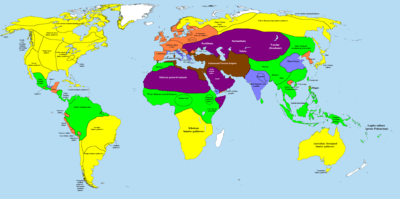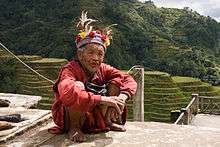Igorot society
The Igorot Society is the term for the collection of several ethnic groups in the Philippines that come from the Cordillera Administrative Region of Luzon. They inhabit the six provinces of Abra, Apayao, Benguet, Kalinga, Ifugao, and Mountain Province, as well as Baguio City. They are a pre-Hispanic highland society that has survived through Spanish colonization.[1] This Prehispanic state is the oldest in the Philippines. This society predates the other pre-Hispanic states in the Philippines (Sultanates of Sulu, Lanao & Maguindanao; Rajahnates of Butuan & Cebu; Kingdoms of Maynila, Tondo & Namayan; the State of Ma-i & the Confederation of Madja-as) which are maritime civilizations, in contrast to this society which is a mountainous high-land society. This society is composed of many tribes, mainly the Bontoc, Ibaloi, Isnag (or Isneg/Apayao), Kalinga, and the Kankanaey.[2]

Ifugao | |||||||||||
|---|---|---|---|---|---|---|---|---|---|---|---|
| c. 500 BC–1601 | |||||||||||
| Status | Kinship Plutocracy | ||||||||||
| Capital | Not specified | ||||||||||
| Common languages | Cordilleran languages | ||||||||||
| Religion | Animism (see also Polytheism) | ||||||||||
| Government | Plutocracy | ||||||||||
| Apo | |||||||||||
| History | |||||||||||
• End of long clan wars between Ifugao clan and warlords of Kalinga and the construction of Banaue Rice Terraces | c. 500 BC | ||||||||||
| 1601 | |||||||||||
| Currency | Barter | ||||||||||
| |||||||||||
| Today part of | |||||||||||
Etymology

The word "Igorot" is an exonym, derived from the Austronesian term for "mountain people" (formed from the prefix i-, "dweller of" and golot, "mountain range"). During the Spanish colonial era, the term was variously recorded as Igolot, Ygolot, and Igorrote, compliant to Spanish orthography.[3]
The endonyms Ifugao or Ipugao (also meaning "mountain people") are used more frequently within the Igorots themselves, as igorot is viewed by some as slightly pejorative.[1]
Initial history
Prior to colonization, Ifugao was a massive highland plutocracy, among the most sophisticated and prosperous of its kind in the whole archipelago and one of the two grandest highland plutocracies in Luzon, the other being the Plutocracy of Kalinga. The state existed for over 2,000 years and have built massive rice terraces that would be a symbol of the province in later time. There were no monarchs in the state. The state was ruled by its council of elders which led the state into a peaceful and prosperous plutocracy which developed one of the best agricultural technologies in Asia at its time. The state consisted of various subgroups which had similar yet somewhat distinct culture and traditions. Conflicts among the Ifugao people were resolved in the most peaceful way possible. Unlike most of the highland plutocracies in the Cordilleras at the time, the Plutocracy of Ifugao had the least conflict with lowland settlers or Ilokanos. Kiangan was known as the birthplace of the Ifugao people and Hungduan as the epicenter of its culture.
References
- Carol R. Ember & Melvin Ember (2003). Encyclopedia of sex and gender: men and women in the world's cultures, Volume 1. Springer. p. 498. ISBN 978-0-306-47770-6.
- Igorot Ethnic Groups
- Albert Ernest Jenks (2004). The Bontoc Igorot. Kessinger Publishing. p. 12. ISBN 978-1-4191-5449-2.
